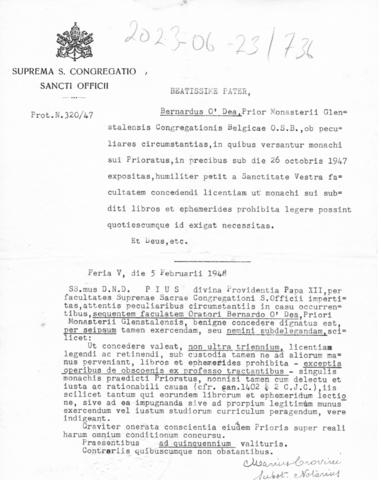Código de referencia
Título
Fecha(s)
- 05-02-1948 (Creación)
Nivel de descripción
Volumen y soporte
Single-sided A4
Nombre del productor
Nombre del productor
Historia administrativa
https://www.newadvent.org/cathen/08026a.htm
The great apostasy of the sixteenth century, the filtration of heresy into Catholic lands, and the progress of heterodox teachings everywhere, prompted Paul III to establish the "Sacra Congregatio Romanae et universalis Inquisitionis seu sancti officii" by the Constitution "Licet ab initio" of 21 July, 1542. This inquisitional tribunal, composed of six cardinals, was to be at once the final court of appeal for trials concerning faith, and the court of first instance for cases reserved to the pope. The succeeding popes — especially Pius IV (by the Constitutions "Pastoralis Oficii" of 14 October, 1562, "Romanus Pontifex" of 7 April, 1563, "Cum nos per" of 1564, "Cum inter crimina" of 27 August, 1562) and Pius V (by a Decree of 1566, the Constitution "Inter multiplices" of 21 December, 1566, and "Cum felicis record." of 1566) — made further provision for the procedure and competency of this court. By his Constitution "Immensa aeterni" of 23 January, 1587, Sixtus V became the real organizer, or rather reorganizer of this congregation.
The Holy Office is first among the Roman congregations. Its personnel includes judges, officials, consultors, and qualificators. The real judges are cardinals nominated by the pope, whose original number of six was raised by Pius IV to eight and by Sixtus V to thirteen. Their actual number depends on the reigning pope (Benedict XIV, Constitution "Sollicita et Provida", 1733). This congregation differs from the others, inasmuch as it has no cardinal-prefect: the pope always presides in person when momentous decisions are to be announced (coram Sanctissimo). The solemn plenary session on Thursdays is always preceded by a session of the cardinals on Wednesdays, at the church of Santa Maria sopra Minerva, and a meeting of the consultors on Mondays at the palace of the Holy Office. The highest official is the commissarius sancti oficii, a Dominican of the Lombard province, to whom two coadjutors are given from the same order. He acts as the proper judge throughout the whole case until the plenary session exclusive, thus conducting it up to the verdict. The assessor sancti officii, always one of the secular clergy, presides at the plenary sessions. The promotor fiscalis is at once prosecutor and fiscal representative, while the advocatus reorum undertakes the defence of the accused. The duty of the consultors is to afford the cardinals expert advice. They may come from the secular clergy or the religious orders, but the General of the Dominicans, the magister sacri palatii, and a third member of the same order are always ex-officio consultors (consultores nati). The qualificators are appointed for life, but give their opinions only when called upon. The Holy Office has jurisdiction over all Christians and, according to Pius IV, even over cardinals. In practice, however, the latter are held exempt. For its authority, see the aforesaid Constitution of Sixtus V "Immensa aeterni" (see ROMAN CONGREGATIONS).
Institución archivística
Historia archivística
Origen del ingreso o transferencia
Alcance y contenido
...

